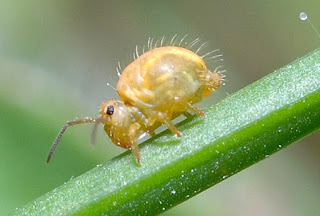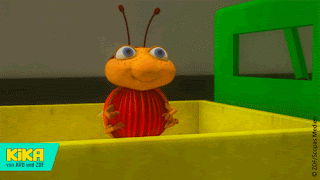The number of species of springtails is upwards of 8,000 and they come in a huge variety of shapes and colors. The chubby-looking round one is the Globular Springtail and it has unmistakable charisma. Others are long and flattish and can easily be mistaken for less-benign bugs. But, all springtails have one thing in common - that which gives them their name, a v-shaped appendage on the rear end of their body that allows them to jump. This body part works just like one of those little toy frogs that you push down and then let go and it pops up in the air. Springtails usually only jump like this as an escape mechanism, otherwise they just scurry around (no flying-they’re wingless). The problem with the spring action is that the bug has no control over it, so their attempted escape can be rather chaotic, especially when there is a large group of them going off all at once. For more on how they do their jumping, check out this article and you can see them go off in this video.
Springtails are often misidentified as fleas. In fact, they’re sometimes called “snow fleas” because some species can and will live in snow. Although springtails are about the size of fleas and jump like them, they do not bite and pose no risk for humans. They are also not harmful to plants. In cases of extreme infestation in outdoor settings, they can begin to nibble on plant roots, but even that action may stimulate additional root branching and result in little to no damage. It is important to make sure that what you have are springtails; more damaging insects can be mistaken for springtails as easily as vice versa.
Here at ARBICO, we often have customers sending pictures or calling and asking about the itty-bitty jumping bugs in their plants. Once we know they have springtails, many people are surprised when we tell them they’re beneficial. Often the first response people have to any bug is to wipe out the multi-legged invaders, but you should resist this response when it comes to springtails. They are a valuable member of the soil microfauna. They feed on decaying organic matter in the soil, which releases minerals that your plants will love. Their feeding action also keeps the soil and its microbial life healthy and thriving and the soil structure aerated, which provides pathways for water and nutrients to move through. All in all, these little guys are quietly doing a great deal of good for your plants.Even though soil springtails are considered beneficial, sometimes springtails in general can be a bit much. They can swarm in very high numbers in and around homes and throughout outdoor spaces. While the “yuck” factor is high when you see this, their presence in and near your home can actually alert you to problems you may not know you have. Springtails are damp-loving creatures and wherever they are gathering you can be assured that there is a consistent source of moisture there. If you see them in houseplants, you’ll know you’re overwatering and simply allowing the plants to dry out should solve the problem (for more on springtails in houseplants, go here. If you are seeing them inside areas with easy access to outside, follow the trail to find the moisture source. Damp landscaping material or soil beds along your outside wall could be sustaining the colony and the smallest of openings letting them in. If you find them deeper in the house under sinks, by floorboards, or in the basement, you could have a serious leakage problem in your walls or foundation. Once the dampness is removed from the equation, the springtails will quickly disappear as well. If you’ve tried all the cultural controls and still don’t have a handle on the infestation situation, you can try sprinkling some Diatomaceous Earth on top of the soil or go the fire-vs-fire route and introduce a predatory insect that will feed on springtails. We carry two very enthusiastic predators that will do the job – Rove Beetles and Stratiolaelaps scimitus (Hypoaspis miles).
Springtails are fascinating little creatures and there is a vibrant community of people out there who study and collect them. The variety of springtails is astonishing and some of them are quite beautiful. Check out this page full of some dazzling examples. And then there is this man who combines exquisitely detailed macro-photography with years of study to provide totally entertaining information on these little bugs. But, of all the neat stuff there is to learn about springtails, I have to admit that I found their mating practices the most intriguing. Creatures of the micro-world often have bizarre (at least to us) reproductive behavior, but I have not come across any others who do it like the Globular Springtails do. You can read about it here - there’s even a video which I promise isn’t pornographic.
Take Care.
Submitted by Pam











No comments:
Post a Comment